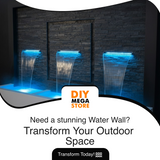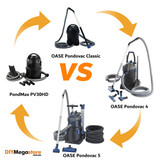316 VERSUS 304 GRADE STAINLESS STEEL WATER SPILLWAYS & FEATURES – IS IT WORTH THE EXTRA COST?
Choosing the Right Stainless Steel for Water Walls: 316L Marine Grade vs 304 Grade
When designing or installing a water wall, selecting the right material is crucial to ensure durability, longevity, and aesthetic appeal. Stainless steel is a popular choice due to its strength and corrosion resistance, but not all stainless steel grades are equal. Two of the most commonly used grades for water walls are 316L Marine Grade and 304 Grade stainless steel. Understanding the key differences between these two can help you make an informed decision for your project.
What is 304 Grade Stainless Steel?
304 stainless steel is one of the most widely used stainless steel alloys, known for its affordability, durability, and corrosion resistance. It consists of 18% chromium and 8% nickel, making it highly resistant to oxidation and rust in general environments.
Pros:
- Cost-effective compared to 316L.
- Strong and durable for most indoor applications.
- Resistant to rust and staining in mild environments.
Cons:
- Not as resistant to chlorides and salty environments.
- Can develop surface corrosion in outdoor or high-moisture settings over time.
What is 316L Marine Grade Stainless Steel?
316L stainless steel is a premium-grade alloy that contains 16% chromium, 10% nickel, and 2-3% molybdenum. The addition of molybdenum significantly enhances its resistance to corrosion, especially against chlorides, saltwater, and harsh weather conditions.
Pros:
- Superior resistance to corrosion, especially in marine and coastal environments.
- More durable in outdoor applications with exposure to chlorine or salt.
- Lower carbon content ("L" designation) minimises weld-related corrosion.
Cons:
- More expensive than 304 stainless steel.
- Slightly softer, making it more prone to scratches compared to 304.
Which One is Better for Water Walls?
The choice between 316L and 304 stainless steel depends on the application environment:
- Indoor Water Walls: If your water wall is installed indoors and is not exposed to chlorine or saltwater, 304 stainless steel is a cost-effective and durable choice.
- Outdoor or Poolside Water Walls: If your installation is near the ocean, a pool, or in a high-humidity outdoor setting, 316L marine-grade stainless steel is the better option due to its superior corrosion resistance.
- Commercial Installations: For high-end architectural designs or commercial spaces where longevity is paramount, 316L is the recommended choice to prevent premature deterioration.
Conclusion
Both 316L and 304 stainless steel offer excellent durability and aesthetics for water walls, but their performance varies depending on environmental exposure. While 304 is suitable for most indoor applications, 316L is the preferred choice for outdoor, poolside, or marine settings due to its enhanced resistance to corrosion. Understanding these differences ensures you choose the right material for a long-lasting and visually stunning water feature.
Need expert advice on water wall materials? Contact us today to discuss your project requirements!
Recent Posts
-
Koi Fish Food: The Ultimate Guide for Australian Koi Keepers
Koi Protein Requirements: Complete Nutrition Guide for Australian Koi Keepers Understanding what yo …14th Nov 2025 -
Ready to Build Your Dream Water Walls?
Your water walls transformation starts with the right supplies and expert guidance. Share your water …18th Sep 2025 -
Best Pond Vacuums Compared: PondMAX PV30HD vs OASE PondoVac Classic, 4 & 5
Keeping your pond clean isn't just about aesthetics—it's essential for fish health, water clarity, a …7th Jul 2025




